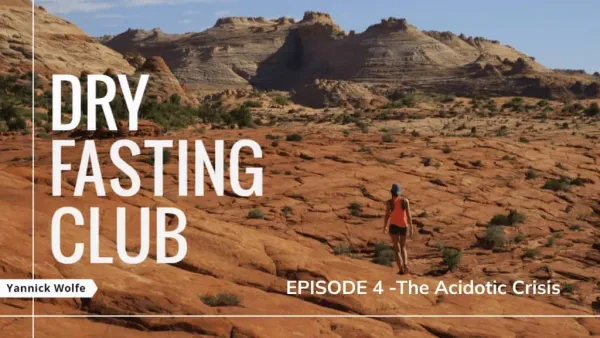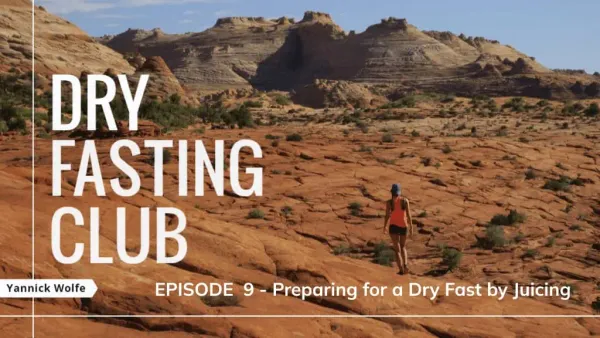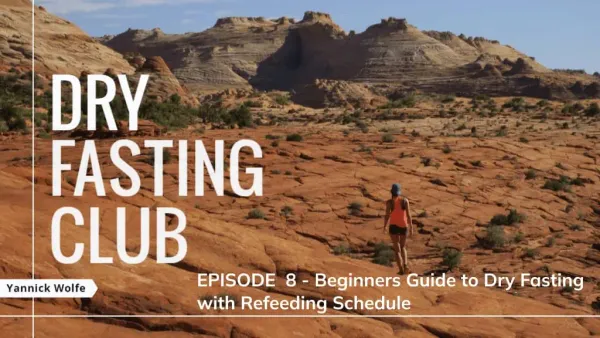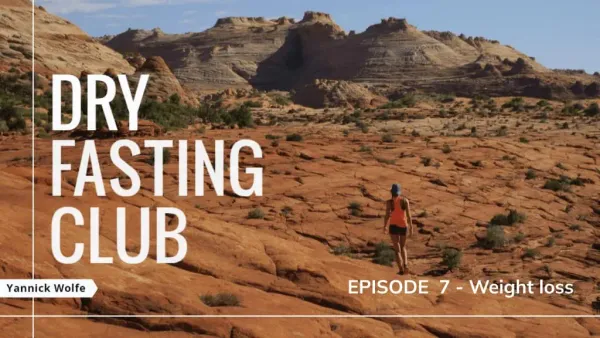Introduction
Welcome to the Dry Fasting Club and the beautiful world of dry fasting, I’m Yannick Wolfe and I hope to be able to guide you on your dry fasting journey. It’s important to note that the information provided here is done to the best of my experience and research, however, it should never be taken as medical advice.
You should always speak to a medical professional about your decision to attempt fasting in the first place. Please treat this information as entertainment only.
I’d also like to let everyone know that if you are interested in fasting, specifically dry fasting; make sure you join the Dry Fasting Club’s discord group. It’s where you’ll find expert fasters that can answer most of your questions as well as like-minded people that are also on the dry fasting journey. The link to the discord, as well as references to the topics discussed will be in the notes. Ok, let’s get started.
Why talk about the Acidotic Crisis?
People usually confuse ketosis with ketoacidosis. Fat is oxidized during both ketoacidosis and ketosis, since it creates ketones. Very simply put, ketone production creates acidity.
- Ketoacidosis usually occurs with diabetics because of low insulin levels. This is a very dangerous situation. Diabetic ketoacidosis basically means that you have high amount of ketones and high amounts of sugar circulating in the body.
- Ketosis, on the other hand, occurs when there’s very little sugar circulating in the blood for an extended period of time, which triggers ketone production as well.
Both of these create an acidic environment that ramps up. Even though there’s probably lots of different mechanisms at play, it seems that the circulating sugar in this situation, is the biggest reason for the danger. Ketosis is viewed as relatively safe, whereas ketoacidosis is dangerous. Ketosis allows the body to create a very good buffer system, where the acid and alkaline environment is very well balanced. There’s also alcoholic ketoacidosis that we won’t discuss here.
Diabetic ketoacidosis
For diabetic ketoacidosis, there’s huge warning signs when it comes to fasting. You’ll need to consult with a doctor, and carefully design your own methods. It can definitely get dangerous. But I do have to point out that over my years of reading people’s experiences, I have seen accounts of past diabetics claiming that fasting had healed their diabetes. So there’s definitely hope, but also a lot for you to read up on. I won’t claim to know anything about diabetes and will not be making any recommendations to fast for this disease.
Reaching the peak
If you’ve ever extended water fasted, tell me if this rings a bell. Starving on the second and third day, constantly thinking about food. You’re weak, you have headaches, and you feel like vomiting for the next 5 days. Why does this happen? It’s because your body is slowly acidifying and moving steadily towards the acidotic crisis peak. It’s this Acidotic crisis, that once over, you finally feel like a million bucks. You hear people saying things like oh after a few days I felt amazing!
While dry fasting, the body undergoes a much stricter and harsher condition than if they were just water fasting. The body gets into a bit of a crisis because it lacks not only food but also water. This makes it so that the body has to scramble quite quickly to produce water and energy. Where is that located? Our fat cells!
The Acidotic Crisis in research
For dry fasting, a lot of research over the years from Russia discovered that the first acidotic crisis usually occurs around the 3rd day of dry fasting. Then it subsides and levels out for a few days. The second acidotic crisis appears around days 9-11. This is the one that supposedly provides the strongest healing. On dry fasting retreats, they aim to reach the second acidotic crisis, but it’s important to note that this is done under strict supervision.
You’re definitely not recommended to go longer than 5 days by yourself, even though lots of dry fasters do up to 7 days at home. With a lot of experience and fasts under your belt, this is very doable.
However, recently, some dry fasting experts have started looking at fractional fasting and combined fasting as a way to avoid having to go 9+ days. This means that multiple 5-day fasts can work just as well as one 9+ day dry fast, if done correctly and within a shorter time span.
Without going into too much detail, the refeeding is very important in between the fractional fasts. You’ll want to look up an episode that talks about refeeding, and adjust it as best as possible to your situation.
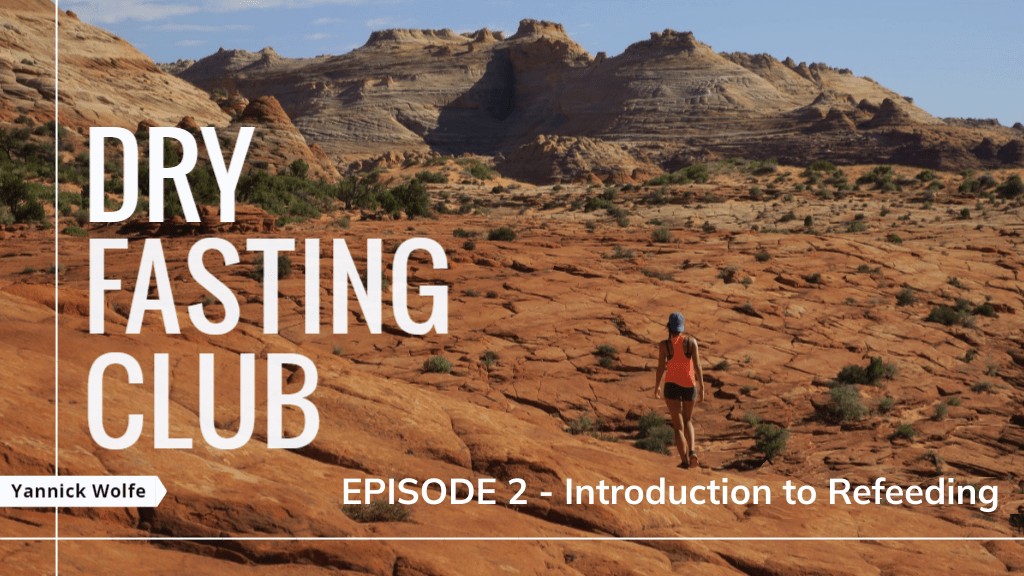
What is the Acidotic Crisis?
The Acidotic crisis refers to the period when your body produces such high amounts of ketones that you hit a certain threshold that does a few things.
- First, it creates a very acidic state in your body which triggers more powerful autophagy.
- Secondly, it triggers mechanisms that start to control the acidosis. That’s why you can get many horrible symptoms when you go through the acidotic crisis but these symptoms go away after a while.
Technically you can enter this state also through a ketogenic diet and ketosis.
Once you hit that threshold called the acidotic crisis, suddenly everything improves dramatically. Your headaches, feelings of weakness, and nausea nearly disappear. The blood pressure stabilizes, tongue starts to clear up, and your mood improves. These are all signs that the body was able to switch to using its own fat reserves at maximum power and has started balancing the pH.
This is why so many people that eat a ketogenic diet, swear by it’s miraculous effects. It’s quite clear that using ketones triggers many benefits in the human body. Moreover, it’s also important to remember that the less carbs you ingest, the more trouble you’ll have retaining your electrolytes. There’s a correlation between the two.
Keto flu
When you eat keto, you can start getting things like the keto flu. The keto flu is a set of symptoms that many people who try the keto diet experience for a few days to a few weeks. It includs: low energy, brain fog, painful headaches, mood swings, constipation, and nausea. When you’re not ingesting carbohydrates like sugar, your glucose levels drop drastically. Whenever the glucose goes, the water and electrolytes go too.
My approach to keto flu
Personally, I always prepare for a fast by intaking extra electrolytes and really hydrating myself. However, when I break the dry fast, I slowly start with magnesium citrate, for its bioavailability, alkalizing properties, and its citic acid which is amazing for its ability to dissolve potential kidney stones. Then I also make sure to use potassium salt in my small refeed meals (but gradually because too high doses of potassium too quickly, can also have negative effects.
Potassium salt should be easy to find at your grocery store. Look for brands like NoSalt or LoSalt, spelled L-O-Salt.

I avoid regular salt for the first day or two and then very slowly increase it. Russian dry fasting doctors have recommendations to avoid salt for the first few days. I believe that they’ve seen a more positive effect from patients who have limited their salt intake after a dry fast.
Electrolytes stability during prolonged fasting
The body does have a beautiful way of stabilizing your electrolytes during prolonged fasting, especially after it passes the acidotic crisis. The sodium retaining mechanism is the strongest, since the hormone aldosterone is upregulated.
This hormone makes you conserve water and it correlates with a higher retention of sodium. It does not have a measured effect on retaining potassium and magnesium. Expect to lose more potassium and magnesium than you would sodium during a dry fast.
Are you starting to notice the patterns here?
Always think of everything as a slow and gradual progression. The fast and acidosis progresses slowly up and up, and the refeed needs to gently go back down slowly. Don’t start bombing straight down the hill, like lots of people who can’t control their cravings. They end up messing up a large portion of their healing. The fast is the breaking down the body’s malfunctions, while the refeed is the rebuilding.
What are symptoms of acidosis in your daily life, that you should be aware of?
Some people are too acidic in their daily life. Let me know if you suffer from any of these:
- Being very irritable, this is caused by the nervous system being thrown off due to the constant acidity.
- Having a hard time breathing, and frequent sighing.
- Pain is magnified meaning having a higher sensitivity to pain.
- Light and sound sensitivity
- Thirst and feelings of dehydration
- Frequent urination
- Exhaustion
- Confusion
A lot of these symptoms start to make me realize that as a long-time runner, I may have had severe electrolyte imbalances throughout my life. I’m sure many of you have experienced this as well. It’s really eye-opening when you get to dig deeper.
My theories about chronic illnesses and especially about covid severity keep evolving. But electrolyte imbalances are still at the top of my list. So why do I think as a long time runner this could have affected me?
📌 High Lactic Acid symptoms
High lactic acid can come from eating too many carbohydrates. Lactic acid is an organic acid produced by the body when glucose (sugar) is broken down to generate ATP (cellular energy) in the absence of oxygen. It builds up lactic acid in muscles and could create an acidic situation. This means that very athletic people have a high chance of being under acidosis frequently. Keep that in mind if you consider yourself an athlete.
📌 High Uric Acid symptoms
That usually comes from eating too much protein, but also can come from eating too many carbohydrates. Eating plenty of low-glycemic carbs — think vegetables, dairy, and some fruits — was linked with reduced uric acid levels. So there’s a correlation between both too many carbs and too much protein. Uric acid is also very closely related to gout and other similar diseases. All of these create a chronic acidic environment in the body.
Acidosis and electrolytes imbalances
What does all of this mean? Well, an acidic state does result in electrolyte imbalances, that is quite clear. Acidosis is often accompanied by hyperkalemia, which means excessive potassium. If you’re thinking wait, isn’t potassium alkalizing? Yes, but read on.
Potassium in this case, moves from the intracellular (inside the cell) to the extracellular (outside the cell) and most of it is released in the urine. So you’re losing it. The same can be seen for hypercalcemia and hypermagnesemia, which is too much calcium and magnesium.
Mentioned electrolytes have an alkalizing effect on the body, so it goes to show further proof of how well your body can adapt to stresses and balance your PH. These states occur through extracellular shifts. It means that it’s being taken out of the cells and into the surrounding acidic environment to fight it.
Think of it as your bones, muscles, and all your cells floating in a vat of weak acid. They won’t disappear right away, but they will slowly get dissolved more and more until the acid is neutralized. If you keep adding acid slowly into the vat, without enough alkaline materials, like in the case of a slightly acidic body, the leaching and dissolving will continue. So now it starts to paint a clearer picture.
Some good solutions to acidosis
What can we do if our lifestyle is creating an acidic environment in the body? Most people will tell you to get an electrolyte panel blood test done. But you need to remember that blood level electrolytes are not a good indication of deficiency or not.
To get an accurate view you’d actually need to monitor the ingestion amount of electrolytes and the urine excretion amount of the electrolytes. Blood levels do not account for the electrolytes primarily residing inside your cells.
Think of it this way: if your body is releasing electrolytes to balance the acidosis in your body, it will show that you have high levels, or even normal levels, of them on a blood test. Even though your levels inside the cells are suffering and deficient. This could create a situation where your doctor says everything looks great, you should be fine! But in reality, you feel terrible, and don’t know that your electrolyte levels are actually suffering.
💊 Supplementing Electrolytes
Taking in higher levels of Minerals such as potassium, magnesium, and calcium have an alkalizing effect on the body. They’re very necessary to help maintain your body’s ph buffer system. If you’re deficient in them, you can create a positive feedback loop which is bad.
These minerals have an even more pronounced alkalising effect if they are bound to citrate. For example as potassium citrate or magnesium citrate. As I mentioned earlier, magnesium citrate has been a game changer for me after fasting.
I have also started taking it a few times a week before bed. I take magnesium l-threonate when I wake up as it’s the most bioavailable for the brain and it does not cause grogginess. Magnesium is also essential in calcium absorption, so I rank it as one of the higher value electrolytes. Most people who are magnesium deficient are also deficient in potassium. It is necessary for almost every cell function including the making of stomach acid, so there’s that as well.
🍔 Don’t drink during meals
Study after study has shown that if you drink during a meal you dilute your stomach acid, which is needed to properly absorb minerals and digest your food. What this meansis that acid is just as important as alkaline minerals. Without strong stomach acid, your digestion and its cascading features get negatively affected. So stay away from antacid pills and high doses of baking soda. Even if they make your acid reflux feel better, you may actually be causing more chronic problems down the line.
On top of all that, our food is grown in nutrient-depleted soils, so right off the bat, a lot of food is less nutrient rich than it used to be. The longer the food is transported, the less nutrients it has.
In fact, most produce loses 30 percent of nutrients three days after harvest. Keep in mind this is mainly vitamin loss when the vitamins get oxidized. These are all compounding effects that we all need to be aware of.
Weight and The Acidotic Crisis
There’s a study by I.B. Belyaeva, called Clinical and laboratory assessment of efficiency of short-term courses of therapeutic fasting in the early stages of bronchial asthma. Although the study focuses on asthma patients, it uses water fasting as the tool, and observes the patients electrolyte levels, acetone concentration in expired breath, and blood PH.
There were 2 different types of patients observed: patients with normal weight, and patients with excessive weight. Although everyone’s time to reach the acidotic peak is different, there was very good correlation between time and excess weight.
In simple terms, the fatter you are, the longer it takes for you to get to through the acidotic crisis. You can expect to feel worse for longer than someone who is a lower weight. Normal weight patients were able to peak around days 4-6.
Patients with excess weight would hit their peak around day 7-8. That’s an interesting observation and something to keep in mind if you’re trying to maximize healing during your fasts. Since dry fasting is about 2.5 times faster, the terrible feeling caused by the acidity will be shorter.

1 –volunteers with normal weight;
2 –patients with excessive weight;
3, 4 –patients with normal weight
Why do we want to reach The Acidotic Crisis for healing during fasting?
Although the acidotic crisis is not perfectly understood from a scientific perspective, we know that its a phenomenon that occurs in everyone, to varying degrees.
Nearly all doctors who use extended fasting therapeutically, agree that this is an important step in the autophagic healing process.
It’s true, most of these doctors are from Russia, but its because dry fasting and therapeutic water fasting has been studied much more extensively.
As new studies come out, they start to show us that there are NEW autophagy mechanisms activated during dry fasting. How crazy is that?
Absolutely unexplored autophagy that triggers stem cell creation. This makes me realize how little we really know about the body. Its responses to stressors like cold and heat shock therapy, and the same with water or dry fasting. You start to realize that although scientific methods improve and we start to understand some mechanisms better. We keep finding out that there is more than meets the eye.
Hybrid fasting
Knowing about the importance of the acidotic crisis, you realize that if you’re doing this for healing, and you don’t have a lot of time, it’s crucial to hit those acidotic peaks. This brings us to ideas that different fasters have played around with. The most popular hack to bring about this crisis faster is to dry fast for 3 days, and then continue with water fasting for up to 10 days.
This can be called hybrid fasting or combined fasting. The beauty of doing this is that you get to cut out about 5 days of water fasting, but get the exact same benefits (or possibly more, considering we don’t even fully understand the extra autophagy mechanisms).
The secrets of dry fasting
Another amazing thing about dry fasting, is that the consensus is that you do not need to prepare with cleansing procedures like enemas. Since there is no water, the body does not deposit toxins in the colon the same way it does during water fasting.
That means that there are even more mechanisms internally that are doing a different type of cleansing. You hear people talking about the dry fasting heat, that occurs around day 3+. The way a lot of people look at it is that dry fasting creates an internal combustion furnace inside your cells, and it rips toxins apart on the spot, while also releasing energy.
The study about the microtubule dependant autophagasomal clusters, showed us that there is a deeper autophagy going on inside the cells during a dry fast. This is quite the opposite during water fasting where regular autophagy focuses on finding ‘bad’ cells and destroying them. In dry fasting it seems that it’s done on an even finer scale.
Not to mention that dry fasting has also shown to drastically increase new stem cell counts. I always tell people that the rich are flying to Mexico to get the newest stem cell therapy at 50,000$ a pop, where they’re injected with cultured stem cells from an embryo or fetus. While the poor man’s stem cell therapy can be done at home, and with the biggest advantage of it being your own body producing your own well adjusted stem cells with less of a risk of rejection. No wonder this is a secret art, who would want the world to find out about this?
Possible consequences of acidosis, and when to choose to break the fast?
🎯 Ending the fast
Knowing when to break the fast or not is very important. That is why one of the main things you’ll often hear is that you need to build up your fasting experience. You’ll hear that you should not start with dry fasting, but water fasting. This allows you to start to learn how your body feels when it is fasting.
It’s like when someone starts to learn how to ski, you don’t send them on the mountain slope for their first run. They go to a bunny hill and practice the basics first. There will be many falls, but eventually they’ll feel ready to ride the mountain.
No one truly knows when to break a fast better than yourself, but without enough experience, you might miss warning signs. It’s always better to gradually increase fasting days. But overall, the general consensus is that if you are in very intense pain, if you are constantly lightheaded, or if have very high blood pressure when sitting still you should end the fast and try again at a later date after refeeding correctly.
🫘 Problems with kidneys
Not enough research has been done on dry fasting and damage to kidneys, although the anecdotal evidence shows that if you don’t have a prior kidney disease, if done properly, the patients heal their sickness, with no kidney injury. There is a study done on 10 healthy individuals who dry fasted for 5 days and were completely fine. We do need more research on this, but as long as you take it slow and listen to your body, you can safely unlock new levels.

Some people worry about kidney stones, and there have been rare occurrences of people passing kidney stones after a dry fast. The argument is that the acidosis helped create a high calcium environment, which is valid. The counterargument is that its usually people who are already susceptible to kidney stones and have had them growing, and the dry fast is pushing them out. I believe there’s some good points to this, and that if anything, it creates an even stronger reason to make sure you are preparing for the fast with magnesium citrate, lemon water, and baking soda. If you’re really worried about kidney stones, you should really up your citric acid game asap.
Summary
Acidosis occurs due to ketosis that ramps up the longer you fast. This ramp-up occurs over several days until it hits a peak called the acidotic crisis.
Remember that after the fast you’ll want to gradually re up your alkalizing minerals like potassium, magnesium, calcium, and bicarbonate. If you’re new to dry fasting or can’t handle extended fasts well. Look into doing fractional or combined fasting to harness the power of the quicker acidotic crisis.
Well, we’re near the end of the episode. As always, references are in the show notes. If I’ve convinced you to try a day or two of dry fasting, maybe I’ve saved you some money on groceries or some bottled water. If you would like to support this podcast and my work at exploring dry fasting topics, I have a link in the show notes where you can donate and buy me a coffee. You’ll also get access to a private server for members. If you’re not able to, leaving a 5-star and a like or a comment goes a long way. If you’d like to give me any ideas on how to improve the show, or any comments, in particular, I’d love to hear from you. Please send me an email to yannick@dryfastingclub.com. Also, if you’ve done extended dry fasting before and would like to discuss your experiences, insights, and anything else, drop me a line and maybe we can record our conversation for a future episode.
That’s it for this episode introducing you to the acidotic crisis. I hope you enjoyed it. Thanks for listening, I hope to see you in the discord group or facebook group. Thank you and good luck on your dry fasting journey!
References
Acidotic crisis and duration of water fasting
Features of a successful therapeutic fast of 382 days’ duration
Preoperative prolonged fasting causes severe metabolic acidosis
Overview of acid-base and electrolyte disorders
